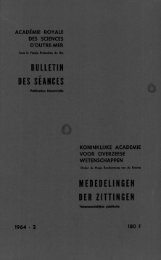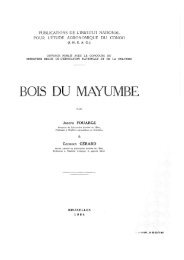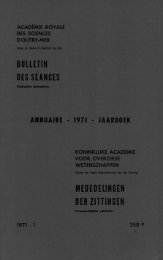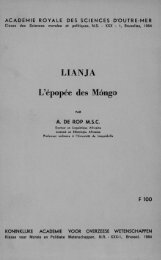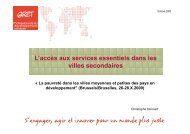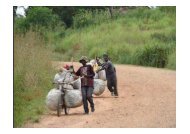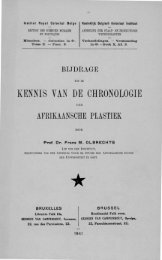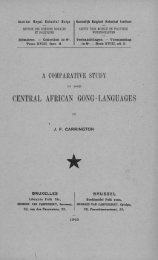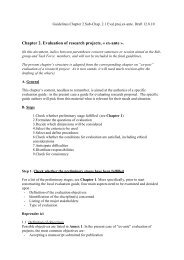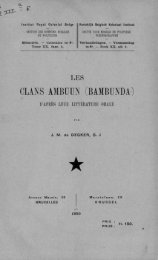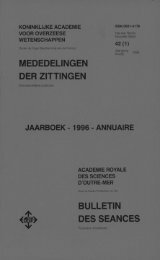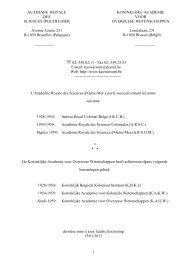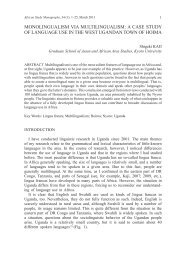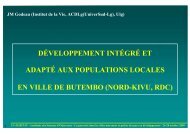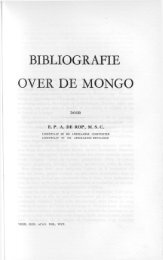KONINKLIJKE ACADEMIE VOOR OVERZEESE WETENSCHAPPEN ...
KONINKLIJKE ACADEMIE VOOR OVERZEESE WETENSCHAPPEN ...
KONINKLIJKE ACADEMIE VOOR OVERZEESE WETENSCHAPPEN ...
Create successful ePaper yourself
Turn your PDF publications into a flip-book with our unique Google optimized e-Paper software.
— 283 —<br />
Table 2<br />
Feed and feeding rate for climbing perch larvae<br />
Periods Home-made feed formulations Feeding rates<br />
(% of fish biomass)<br />
Day lst-5th Boiled yolk chicken egg 50-60<br />
Day 6th-15th 50 % fish meal and 50 % soybean meal 30-50<br />
Day 16th-30th 50 % fish meal, 30 % rice bran, 20 % soybean meal 8-10<br />
Day 31st-45th 30 % fish meal and 70 % rice bran 5-7<br />
2.1.2.3. Experiment 3: Intensive Culture of Climbing Perch in Earthen Ponds<br />
— Experimental Design<br />
The treatment of intensive culture system was carried out in Phu Loi village,<br />
Chau Thanh district, Can Tho province. The culture system includes two earthen<br />
ponds with a total area of 3,770 m2, including fish pond 1 (270 m2) and fish<br />
pond 2 (3,500 m2) at two stocking densities of 30 and 50 fish/m2 (treatment I:<br />
30 fish/m2, treatment II: 50 fish/m2). During a culture period of six months, the<br />
fish were fed with mainly home-made feed (by-products of processing factory or<br />
agriculture) at a rate of 3-8 % fish biomass/day, and adjusted following the<br />
growth rate of fish.<br />
— Data Collection<br />
Water quality parameters such as water temperature (°C), water transparency<br />
(cm), water pH were measured at 7:30 a.m. and 14:00 p.m. The other parameters<br />
such as dissolved oxygen, NNR,\ P-PCV, COD, H2S and natural food resources<br />
(phytoplankton, zooplankton and zoobenthods) were measured monthly.<br />
Number of spawned fish, fecundity (number of eggs per kg of female), fertilization<br />
rate (%), hatching rate (%), and survival rate of larvae (%) after three free<br />
swimming days, daily weight gain (g/day) and special growth rate (%/day) were<br />
also recorded every fifteen days for nursing (ten fish) and every month for growing<br />
out (thirty fish).<br />
— Water Quality Management<br />
Water samples were collected monthly at the same time as fish samples in<br />
ponds and analysed following the methods used by the Central Laboratory,<br />
College of Aquaculture and Fisheries Sciences, Can Tho University:<br />
— Water temperature (°C): by using temperature metre (HANNA);<br />
— Transparency: by using Secchi disc;<br />
— DO (mg/1): by using Winkler method (DO metre);<br />
— Water pH: by using pH metre and pH paper;<br />
— N-NH,': by using Indophenole method;<br />
— P-P043 : by using Molibden blue method;



